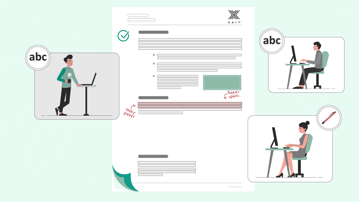It is more than teamwork — it’s a structured process that ensures accuracy, consistency, and compliance across business-critical documents.
For organizations producing high-value deliverables such as tender documents, contracts, proposals, or regulatory submissions, collaborative editing is essential. Done well, it reduces delays, improves document quality, and gives team members confidence that the final output reflects their best work.
Challenges of Working on the Same Document Simultaneously
Collaborative document editing without structure often creates more problems than it solves. Teams that rely on email attachments, shared drives, or unstructured collaboration tools face common issues such as:
- Multiple versions of the same document circulating at once
- Security risks from uncontrolled documents share or unsecured storage
- Feedback scattered across emails, chats, or spreadsheets
- Long review cycles without clear ownership or accountability
Instead of accelerating progress, these problems slow delivery, introduce risk, and frustrate contributors.
Structuring a Co-Authoring Team
Technology is only part of the solution. Effective co-authoring also depends on people and process. Clear roles such as author, reviewer, and approver give structure to collaboration. Combined with the right workflows, this ensures that teams collaborate effectively, so working together results in clarity, not chaos.
Key Features That Power the Best Collaborative Document Editing
Document collaboration tools go beyond simply letting multiple users type in the same file. For professional teams, advanced, co-authoring software is required to support efficiency, compliance, and scale.
Version Control: One Source of Truth
- Eliminates confusion caused by conflicting drafts
- Keeps every contributor aligned on the latest version
- Reduces costly mistakes and rework
Access Control: Secure and Structured Collaboration
- Role-based permissions protect sensitive content
- Writers, reviewers, and approvers have clear boundaries
- Strengthens compliance and accountability across large teams
Integrated Review Tools: Feedback in Context
- Feedback is kept inside the document itself
- Comments are linked directly to specific text
- Shortens review cycles and avoids missed changes
Parallel Editing: Faster Progress Without Version Chaos
- Replaces slow, sequential editing with working on the same document at the same time
- Allows documents simultaneously to be refined by multiple contributors
- Removes the version chaos that plagues traditional workflows
Technology That Enables Effective Co-Authoring
Complex document management tools provide the foundation for structured, enterprise-ready teamwork. Key capabilities include:
- Real-time collaboration at scale – dozens or even hundreds of contributors edit documents simultaneously
- Structured workflows – built-in processes for drafting, reviewing, and approving
- Automated formatting – consistent styles, layouts, and numbering applied automatically
- Secure collaborative authoring – encryption, access control, and audit trails to meet compliance requirements
This transforms co-authoring from an ad-hoc activity into a predictable, repeatable process for producing high-quality documents under pressure.
Streamlining Co-Authoring with Templates and Workflows
Collaboration is smoother when team members start with standardized templates and follow clear workflows. Automated formatting ensures every section, heading, and page number is consistent without manual effort. This reduces rework, improves readability, and delivers consistent user experiences across large documents.
Suggested Content


Scaling Efficiency with a Content Library
An intelligent content library gives teams a competitive edge. By storing and organizing approved content from past projects, organizations create a repository of reusable, high-quality material. Each completed project strengthens the library, reducing the time needed to build new documents and ensuring consistency across bids, proposals, and reports.
The AI-Powered Content Library: Smart, Safe Reuse
Modern AI-powered collaboration tools go beyond keyword search. They analyze context, understand intent, and recommend the most relevant approved content.
For example, during tender writing with AI, the system can surface proven answers from past submissions, helping teams collaborate faster while maintaining compliance and accuracy.
This approach builds a living knowledge base of thousands of reusable components, making document creation:
- Smarter
- Faster
- More reliable
- Secure — with AI trained safely on company data
From Process to Strategic Advantage
When collaborative editing is managed effectively, the benefits extend far beyond efficiency:
- Faster turnaround times for high-stakes documents
- Improved quality through structured workflows
- Stronger compliance and accountability
- Aligned, engaged team members across locations and disciplines
For everyday notes, lightweight collaboration tools may suffice. But for tenders, contracts, or regulatory submissions, enterprise-grade document collaboration software provides the structure, security, and scalability required to succeed under pressure.
Done right, collaborative document editing turns complexity into clarity — helping organizations edit documents simultaneously and deliver accurate, compliant outputs faster, at scale.









